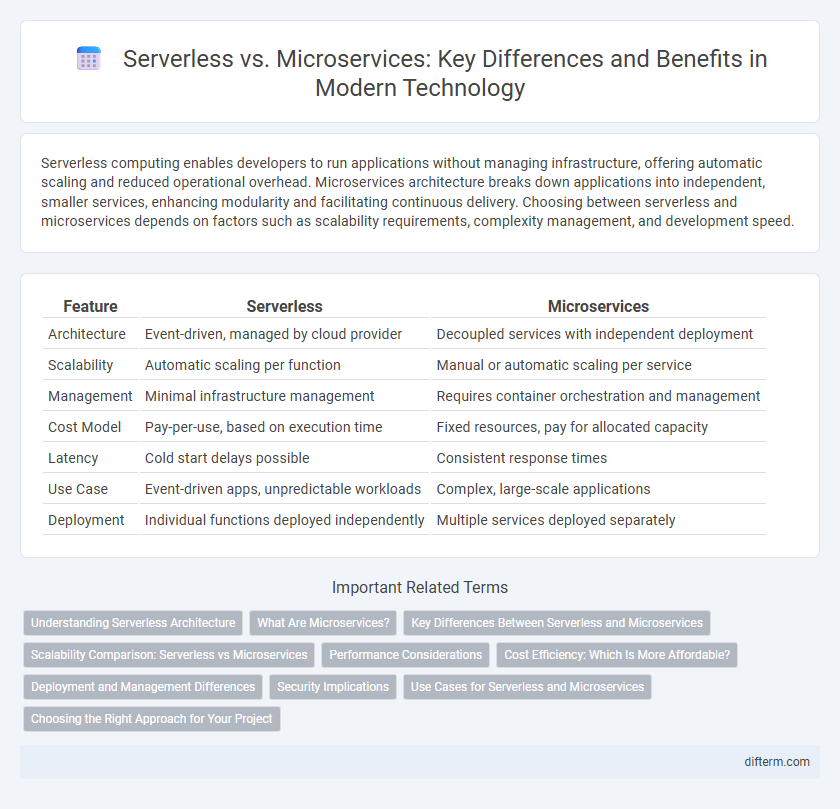Serverless computing enables developers to run applications without managing infrastructure, offering automatic scaling and reduced operational overhead. Microservices architecture breaks down applications into independent, smaller services, enhancing modularity and facilitating continuous delivery. Choosing between serverless and microservices depends on factors such as scalability requirements, complexity management, and development speed.
Table of Comparison
| Feature | Serverless | Microservices |
|---|---|---|
| Architecture | Event-driven, managed by cloud provider | Decoupled services with independent deployment |
| Scalability | Automatic scaling per function | Manual or automatic scaling per service |
| Management | Minimal infrastructure management | Requires container orchestration and management |
| Cost Model | Pay-per-use, based on execution time | Fixed resources, pay for allocated capacity |
| Latency | Cold start delays possible | Consistent response times |
| Use Case | Event-driven apps, unpredictable workloads | Complex, large-scale applications |
| Deployment | Individual functions deployed independently | Multiple services deployed separately |
Understanding Serverless Architecture
Serverless architecture enables developers to build and run applications without managing underlying infrastructure, relying on cloud providers like AWS Lambda, Azure Functions, or Google Cloud Functions to automatically scale and allocate resources. This model reduces operational complexity and costs by executing code only when needed in stateless compute containers, contrasting with microservices where services are independently deployed and managed. Understanding serverless architecture involves recognizing its event-driven nature and integration with other cloud services, optimizing for rapid development and scalability.
What Are Microservices?
Microservices are an architectural style that structures an application as a collection of small, loosely coupled services, each focused on a specific business capability. These independent services communicate through APIs, enabling scalable, flexible, and maintainable systems. By isolating functionalities, microservices improve deployment speed and fault isolation compared to monolithic architectures.
Key Differences Between Serverless and Microservices
Serverless architecture abstracts infrastructure management by automatically scaling functions and charging based on execution time, while microservices involve independently deployable services with dedicated runtimes and resources. Serverless offers event-driven execution and reduced operational overhead, whereas microservices provide fine-grained control over service development, allowing for diverse technology stacks and persistent state management. The choice impacts scalability, latency, and maintenance complexity, with serverless suited for variable workloads and microservices favored for complex, long-running applications.
Scalability Comparison: Serverless vs Microservices
Serverless architecture enables automatic scaling by dynamically allocating resources in response to incoming traffic, making it ideal for unpredictable workloads. Microservices require manual scaling configurations for individual services, offering granular control but demanding more operational overhead. Serverless excels in rapid, event-driven scalability, while microservices provide steady, customizable scalability tailored to business needs.
Performance Considerations
Serverless architectures automatically scale based on demand, reducing latency and optimizing resource utilization without manual intervention. Microservices require careful orchestration and network management to minimize communication overhead, impacting response times and throughput. Performance in serverless setups benefits from ephemeral function instances, whereas microservices offer fine-tuned control over persistent service deployments.
Cost Efficiency: Which Is More Affordable?
Serverless computing eliminates the need for provisioning and managing servers, reducing operational costs by charging only for actual usage, which makes it highly cost-efficient for variable workloads. Microservices architecture allows independent scaling of components, optimizing resource allocation but may incur higher fixed costs due to infrastructure management and continuous deployment needs. For unpredictable or fluctuating demand, serverless offers greater affordability, while microservices can be more cost-effective in steady, high-volume environments.
Deployment and Management Differences
Serverless architectures eliminate the need for explicit server management, allowing automatic scaling and deployment through cloud providers' infrastructure, which significantly reduces operational overhead. Microservices require container orchestration tools like Kubernetes for deployment and management, demanding more complex setup but offering fine-grained control over individual services. The choice affects deployment velocity, resource utilization, and maintenance complexity, with serverless favoring rapid deployment and microservices providing flexible service management.
Security Implications
Serverless architectures reduce attack surfaces by abstracting infrastructure management, minimizing patching responsibilities, and isolating functions with defined permissions. Microservices enable fine-grained security controls through service segmentation, facilitating customized authentication, authorization, and network policies per service. Both models require vigilant identity and access management, but serverless demands stricter event-driven security monitoring while microservices benefit from comprehensive API gateway protections.
Use Cases for Serverless and Microservices
Serverless computing excels in event-driven applications such as real-time file processing, IoT backend services, and rapid API development where automatic scaling and minimal infrastructure management are crucial. Microservices architecture suits complex, large-scale systems requiring independent deployment, scalability, and flexibility, often used in e-commerce platforms, financial services, and enterprise applications. Both approaches optimize cloud resource utilization but cater to different operational needs and development workflows.
Choosing the Right Approach for Your Project
Choosing the right approach between serverless and microservices depends on your project's scalability requirements, deployment complexity, and operational overhead. Serverless architecture offers automatic scaling and reduced infrastructure management, ideal for event-driven applications with unpredictable workloads. Microservices provide granular control and flexibility, enabling independent development, deployment, and maintenance of discrete services suited for complex, large-scale systems.
serverless vs microservices Infographic

 difterm.com
difterm.com